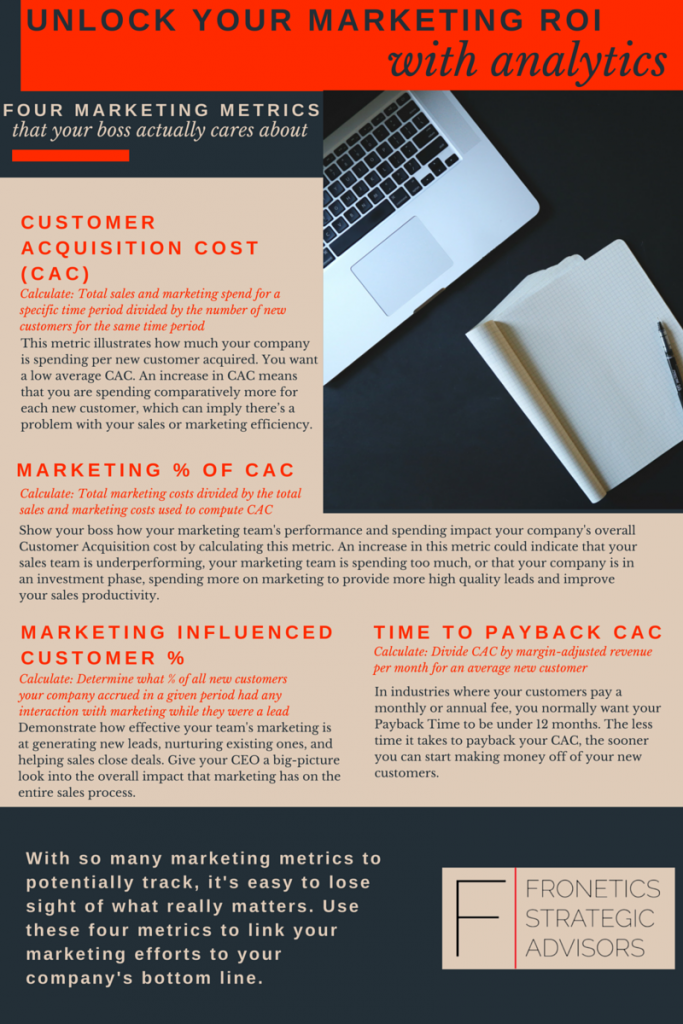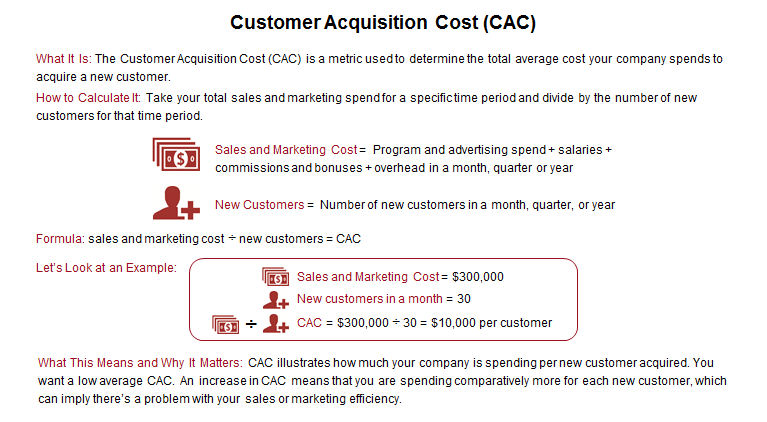![Unlocking Your Marketing ROI with Analytics [infographic]](https://www.fronetics.com/wp-content/uploads/2024/10/Fronetics-Marketing-ROI-800x675.png)
by Fronetics | Sep 9, 2015 | Blog, Content Marketing, Data/Analytics, Marketing
In the age of big data, everything in marketing is measureable – and that’s not necessarily a good thing. As Dimitri Maex of Ogilvy Consulting puts it, “marketers are drowning in numbers because they are focused on what they can measure rather on what they should measure.” Unfocused efforts to evaluate the success of your marketing activities can lead to a host of problems. Central to these problems, though, is the failure to measure and report activities in a way that clearly demonstrates the link between marketing and your company’s bottom line. Check out our infographic that details four marketing metrics guaranteed to resonate with your CEO (and our guide to the 6 marketing metics your boss really cares about).

You might also be interested in:
When it comes to marketing we work with our clients to create and execute strategies that drive success and elevate their brand position within the industry. Unlike other firms, we align marketing programs with business objectives and, through a data driven approach, are able to deliver results with a targeted ROI. Our team is comprised of strategists, marketing professionals, writers, designers, and experts in social media. Together we leverage our experience to increase brand awareness, position our clients as thought leaders, drive meaningful engagement with prospects and customers, and help businesses grow.


by Fronetics | Sep 8, 2015 | Blog, Data/Analytics, Marketing
The profile of marketing has definitely been raised lately. With a full 63% of businesses planning to increase their marketing budgets this year, its clear business leaders are looking directly to their marketing departments to drive growth. Along with expanding budgets and more pressure to produce results, marketing metrics are being more heavily scrutinized by executives; marketing departments are being asked to prove the worth of the increased investment in their marketing efforts. And with an enormous amount of potential data to track, marketing can seem more like big data. The good news is it doesn’t have to. Successfully presenting the value of your marketing efforts means showing your boss the metrics that will resonate and prove that you’re moving the needle where it really counts.
Do you know which metrics actually matter to your boss? Rather than talking about per-post Facebook engagement and other “soft” metrics, can you tell your boss, for example, if your company is spending more money this year to acquire new customers than it did last year? Let’s take a look at how you can calculate your company’s Customer Acquisition Cost (CAC) and why your boss actually does care about it.

Reporting on measurements that link your marketing efforts to the company’s bottom line, such as Customer Acquisition Cost (CAC), will put your marketing team in a much better position to make the case for executive support of current and future budgets and strategies. For more metrics that matter, download our guide to The Six Marketing Metrics That Your Boss Actually Cares About. Our 10-page guide lays out the six marketing metrics that will prove the value of your marketing efforts, along with formulas and examples to help you calculate your own metrics and explanations of why your boss finds these metrics so important.


by Fronetics | Sep 3, 2015 | Big Data, Blog, Data/Analytics, Logistics, Strategy, Supply Chain

Big data is, well, big. The term has gotten lots of buzz the past few years. But it’s big in other ways as well. According to McKinsey big data is defined as “datasets whose size is beyond the ability of typical database software tools to capture, store, manage, and analyze.” A 2014 Forbes article has 11 other helpful definitions.
With current technologies, there are increasing amounts of information to be gathered and exchanged in the world, creating more opportunities for businesses to harness that information and chart a course or tweak processes based on that information. According to an Accenture study, “97% of executives report having an understanding of how Big Data analytics can benefit their supply chain, but only 17% said that they have implemented it in at least one supply chain function.”
In a Boston Consulting Group article, Making Big Data Work: Supply Chain Management, the authors suggest three high-potential opportunities for supply chain management to take advantage of big data. Their suggestions help parse through the complicated, overwhelming network of big data. As they suggest, “with so much available data and so many improvable processes, it can be challenging for executives to determine where they should focus their limited time and resources.” Let’s have a look at the authors’ ideas, as gathered through research, on how to “increase asset uptime and expand throughout, engage in preventive maintenance of production assets and installed products, and conduct near real-time supply planning using dynamic data feeds from production sensors and the Internet of Things.”
Visualizing Delivery Routes
Big data, in the form of geoanalytics, can be used to better manage supply chain routes and help reduce transportation costs by 15-20%, especially when other partner companies are trying to coordinate deliveries. “The companies learned that they shared similar patterns of demand. Vehicle-routing software also enabled rapid scenario testing of dozens of route iterations and the development of individual routes for each truck. Scenario testing helped the companies discover as much as three hours of unused delivery capacity on typical routes after drivers had covered their assigned miles.” Real-time data from live traffic feeds, combined with past data helped to create new forecasts and eliminate wasted time.
Pinpointing Future Demand
In today’s volatile marketplace, relying on sales predictions can be risky and inaccurate, at best, a disaster at worst. According to the BCG article, advanced languages can now work together to create a most accurate forecast, freeing up sales people and their precious time to combat other issues and convert leads. “Advanced analytical techniques can be used to integrate data from a number of systems that speak different languages—for example, enterprise resource planning, pricing, and competitive-intelligence systems—to allow managers a view of things they couldn’t see in the past.”
Simplifying Distribution Networks
The European consumer goods company profiled in the BCG article, used advanced analytics to downsize from 80 factories across 10 countries, down to 20 factories. The distribution network shrunk, and efficiency and savings increased, the latter by 8%. Working with big data can help examine a diverse amount of information never before analyzed. Taking complex data and knowing how to handle the data can turn complexity into simplicity.
Marcelo Simiao, Lean Manager— Operations at Munters, seems to concur with the findings, and believes big data can make sweeping changes.
“Companies are struggling with today’s greater demand volatility. The Order-to-Delivery processes have been the focus of many improvement projects and lean initiatives that aim to reduce costs and improve response times. But most of today’s organizations have their supply chain functions fragmented into several different departments, creating process improvement projects that have results limited to the data they have at hand. This approach often doesn’t deliver value to the end customer. Big Data is changing this scenario by integrating the voice of the customer, sales and the entire supply chain. This integration and thorough data analysis allows organizations to align all of their focus on key projects that are not limited by functions, will improve customer satisfaction, and deliver results directly into the company’s bottom line.”

by Fronetics | Sep 2, 2015 | Blog, Marketing, Social Media, Strategy, Talent

92% of businesses use social media as a recruitment tool – and 75% of hiring managers say they check out candidate’s social media profiles. With hiring managers and recruiters using social media to post jobs and identify great talent, it is obvious that you need to use social media in your job hunt. What isn’t as obvious is how to do so without your current employer finding out.
Here are 4 tips for conducting a successful and stealthy job hunt:
1. Check/change your settings
Before you do anything check and change the settings on your social networks.
By default, social networks are set up to notify your connections of: changes made, connections made, and groups you join. Change this. Go into your settings on each of the social networks you are on and change your settings so that you can fly under the radar.
2. “Dress” professionally
You only have one chance to make a first impression. Your social media profile may be the first impression hiring managers and recruiters have of you. Your profile is also part of your professional brand. It’s therefore important to:
- Use a professional picture (no pets, no cropped arms)
- Remove party pictures and anything else that is not professional
- Be consistent with your personal branding across your profiles.
3. Optimize your social media profile(s)
Optimize your social media profiles to match the job you want. I’m not saying you should make up experience or skills, rather I am saying that you need identify the skills hiring managers and recruiters will be looking for, and highlight your applicable skills and experience. You want to optimize your profile so that your profile will not only showcase your qualifications, but will also ensure that your profile will show up when hiring managers and recruiters are searching for the ideal candidate for your dream job.
How do you do this? Start by defining your target industry and position. As you research companies and job descriptions that match your target make note of keywords (not buzzwords), skills, and qualifications that are recurring. Optimize your social media profile(s) to include these keywords and to highlight your relevant skills and experience.
4. Research, research, network
Research with the objectives of: identifying target companies and networking.
Use the keywords you identified in defining your target industry and position and search social networks for these keywords. (Don’t forget to search groups. LinkedIn groups, for example, are essential in your social media job hunt.) When your search turns up a company that looks to be a good match, look through your connections to learn if there is someone who can introduce you to an employee at the company (just remember not to use your employer or colleagues to make the connection). A connection is an opportunity to learn more about the company – the culture, opportunities, and challenges.
Employing these 4 techniques will help you use social media to find a job – without getting fired.
One thing to remember – a social media job hunt will prove much more successful if you have a strong network. Creating and building a network when you start your job search will leave you at a disadvantage. Networking is an action item necessary for your professional and personal growth. If you view networking as more than just a job search must, you will gain a competitive edge and will be in a much better place when it is time to start your search. So, get out there and “network your face off.”

by Fronetics | Aug 27, 2015 | Blog, Content Marketing, Marketing, Social Media, Strategy
 Content marketing has become a key marketing strategy for many businesses. Statistics show that content marketing generates three times more leads than traditional marketing methods – and those leads cost an average of 62% less. At Fronetics, we’ve built our content marketing services around one goal – helping our clients grow. We’re harnessing the power of content to help our clients connect and engage with leads and prospects in meaningful ways. And our clients are enjoying faster growth and higher profits because of it.
Content marketing has become a key marketing strategy for many businesses. Statistics show that content marketing generates three times more leads than traditional marketing methods – and those leads cost an average of 62% less. At Fronetics, we’ve built our content marketing services around one goal – helping our clients grow. We’re harnessing the power of content to help our clients connect and engage with leads and prospects in meaningful ways. And our clients are enjoying faster growth and higher profits because of it.
How do we use content to support our clients in their business growth?
We create quality content that helps our clients connect with leads and customers in a number of ways. First, we appeal to and engage potential customers by creating relevant content that’s aligned with the needs of our client’s target audience. Then, we nurture those leads into customers by proving the value of our clients’ products and services. Even after they become customers, we work to create positive customer experiences that make it easy for them to recommend our clients to others.
Services offerings
Here’s a quick breakdown of some the service offerings included in our comprehensive approach to content marketing:
Content strategy
Research has shown that B2B and B2C companies with a documented content strategy in place are more effective than those without one.
At Fronetics, we work with our clients to create a content strategy individualized for their specific situation and needs. We learn about our client’s business, target customers, industry, and competition. We also conduct an audit of current content and digital assets. All of this information is used to create an effective content strategy.
Content creation
There is a lot of content out there. If you want your content to stand out and drive profitable customer action you need quality content. At Fronetics, we create quality content that is keyword-optimized. Also, unlike other firms, we don’t outsource content creation. By keeping all content creation in-house we are able to ensure a quality product.
Lead generation
Once we’ve helped our clients draw visitors to their website, we work to identify potential customers and manage their leads. We create and couple high-value content like white papers and eBooks, with strategic calls-to-action that direct visitors to landing pages expertly designed to convert website visitors into leads.
Lead nurturing and customer acquisition
We work closely with our clients to develop a lead nurturing strategy to convert leads into paying customers using email and marketing automation. By segmenting leads and sending them targeted content designed to catalyze engagement, we help our clients build relationships – and importantly, trust.
Social media
Social media is an incredible tool; however, for it to be effective it must be driven by strategy, be consistent, and must have someone managing the execution. At Fronetics, our social media strategists distribute content, curate content, engage your target audience, and monitor your social networks. We develop a social media strategy that aligns with your company’s goals. We analyze your competition, classify your target audience & cultural attributes, identify the influencers in your industry, recommend platforms, detail best engagement practices, create social media schedules, and identify specific tactics that deliver results. Through the proper execution of social media, your brand is given a voice and personality, and becomes more accessible to your target audience.
Analytics and reporting
At Fronetics we take a comprehensive data driven approach to marketing. Metrics measure success, drive strategy, and demonstrate ROI. We provide our clients with monthly marketing reports.
In short, our content marketing strategies drive success for our clients. The Fronetics team is comprised of strategists, marketing professionals, writers, designers, and experts in social media. Together we leverage our experience to increase brand awareness, position our clients as thought leaders, and drive meaningful engagement with prospects and customers – all with the goal of helping our clients grow.
Get in touch with us today for a free consultation to find out if our retainer services, full or half day workshops, or a personalized service offering is right for your business. See how Fronetics can help your business grow.
![Unlocking Your Marketing ROI with Analytics [infographic]](https://www.fronetics.com/wp-content/uploads/2024/10/Fronetics-Marketing-ROI-800x675.png)








